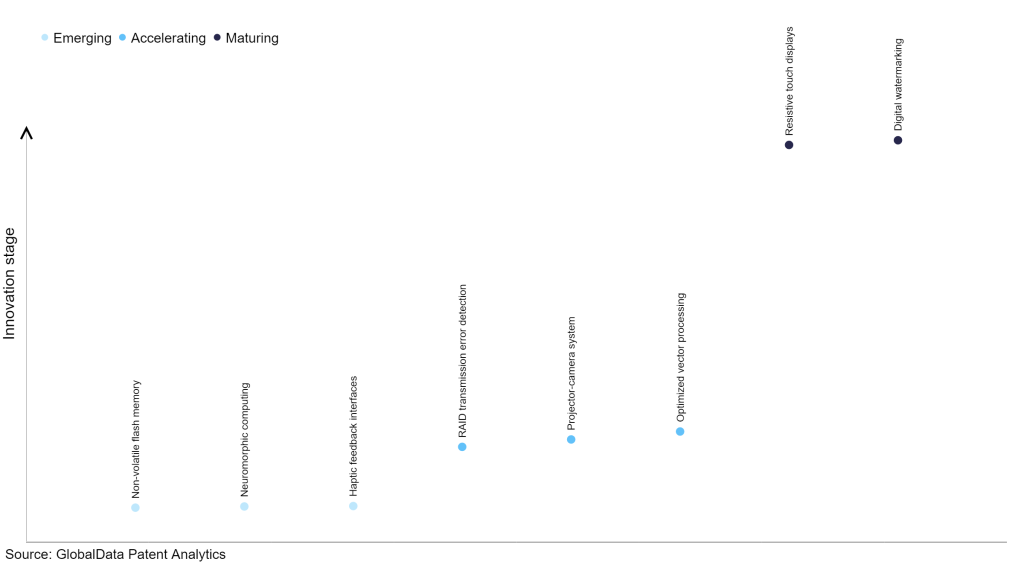The technology industry continues to be a hotbed of patent innovation. Activity is driven by the growing demand for immersive experiences in entertainment and gaming industries, advancements in computing power and audio processing algorithms, proliferation of virtual reality (VR) and augmented reality (AR), and growing importance of technologies such as head-related transfer functions (HRTFs), ambisonics, and 3D audio rendering engines. In the last three years alone, there have been over 1.5 million patents filed and granted in the technology industry, according to GlobalData’s report on Innovation in technology: binaural spatial audio. Buy the report here.

Access deeper industry intelligence
Experience unmatched clarity with a single platform that combines unique data, AI, and human expertise.
However, not all innovations are equal and nor do they follow a constant upward trend. Instead, their evolution takes the form of an S-shaped curve that reflects their typical lifecycle from early emergence to accelerating adoption, before finally stabilizing and reaching maturity.
Identifying where a particular innovation is on this journey, especially those that are in the emerging and accelerating stages, is essential for understanding their current level of adoption and the likely future trajectory and impact they will have.
185+ innovations will shape the technology industry
According to GlobalData’s Technology Foresights, which plots the S-curve for the technology industry using innovation intensity models built on over 1.6 million patents, there are 185+ innovation areas that will shape the future of the industry.
Within the emerging innovation stage, non-volatile flash memory, neuromorphic computing, and haptic feedback interfaces are disruptive technologies that are in the early stages of application and should be tracked closely. RAID transmission error detection, projector-camera system, and optimized vector processing are some of the accelerating innovation areas, where adoption has been steadily increasing. Among maturing innovation areas are resistive touch displays and digital watermarking, which are now well established in the industry.
Innovation S-curve for the technology industry

Binaural spatial audio is a key innovation area in technology
Binaural spatial audio pertains to generating a three-dimensional auditory encounter for individuals through technology emulating natural human auditory perception. This process entails recording sound with a pair of microphones representing the left and right ears and employing signal processing methods to manipulate the volume and timing of sound in each ear, thereby establishing a perception of spatial orientation. Binaural spatial audio finds frequent application in VR, AR, and similar immersive audio scenarios.
GlobalData’s analysis also uncovers the companies at the forefront of each innovation area and assesses the potential reach and impact of their patenting activity across different applications and geographies. According to GlobalData, there are 65+ companies, spanning technology vendors, established technology companies, and up-and-coming start-ups engaged in the development and application of binaural spatial audio.
Key players in binaural spatial audio – a disruptive innovation in the technology industry
‘Application diversity’ measures the number of applications identified for each patent. It broadly splits companies into either ‘niche’ or ‘diversified’ innovators.
‘Geographic reach’ refers to the number of countries each patent is registered in. It reflects the breadth of geographic application intended, ranging from ‘global’ to ‘local’.
Among the companies innovating in binaural spatial audio, Nokia is one of the leading patents filers. The company’s patents are aimed at describing a technique that involves generating a spatial audio representation of a sound environment from a chosen viewpoint. This environment consists of audio objects, each associated with specific audio content and positioned within the audio space. The process encompasses receiving input indicating the selected listening position and orientation, identifying interactions with a primary audio object based on predefined criteria, adjusting the primary audio object along with linked objects, and producing a spatial audio signal. This signal incorporates audio from the altered primary object in a particular spatial location within the sound environment relative to the chosen listening position and orientation. It also includes audio from the adjusted linked objects. Other prominent patent filers in the space include Qualcomm and Sony Group.
In terms of application diversity, Qualcomm leads the pack, while Nokia and Sony Group stood in second and third positions, respectively. By means of geographic reach, Roland held the top position, followed by Huddly and Qualcomm.
Binaural spatial audio technology finds extensive application in fields such as virtual reality, augmented reality, gaming, and entertainment, offering a heightened level of immersion and realism. By replicating the natural perception of sound in three dimensions, it immerses listeners in a lifelike auditory environment. It enhances storytelling, gaming experiences, and simulations by providing accurate spatial cues, thereby deepening user engagement and emotional resonance. Additionally, binaural spatial audio plays a pivotal role in accessibility, offering an inclusive audio experience for individuals with hearing impairments.
To further understand the key themes and technologies disrupting the technology industry, access GlobalData’s latest thematic research report on Technology.
Data Insights
From

The gold standard of business intelligence.
Blending expert knowledge with cutting-edge technology, GlobalData’s unrivalled proprietary data will enable you to decode what’s happening in your market. You can make better informed decisions and gain a future-proof advantage over your competitors.







